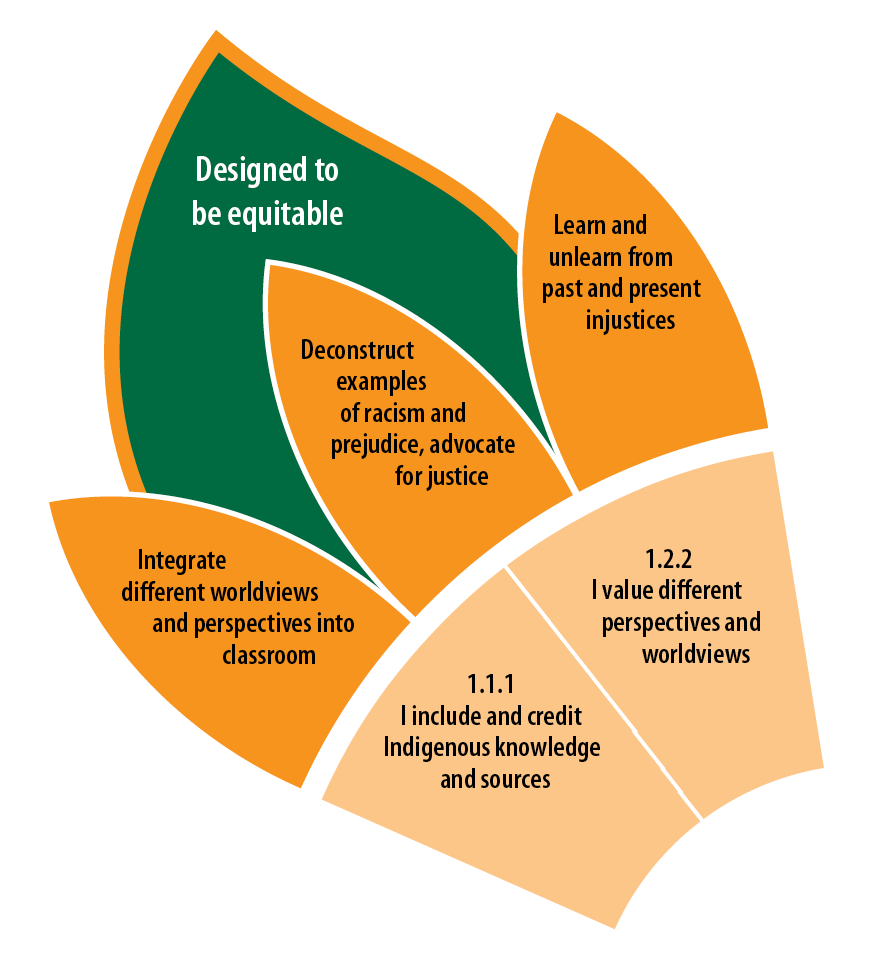Designed to be Equitable: An EDI Principle
Are we integrating Indigenous knowledge and sources into our classrooms and course design?
By Gwenna Moss Centre for Teaching and LearningThis article is part of a series about integrating EDI principles into our teaching and learning design and practices. It is a collaboration between Indigenous and non-Indigenous staff members.
Modelling how we value different perspectives and worldviews, including the integration of Indigenous knowledge and sources in our course design, helps students feel represented and seen in our classes.
In A Teaching Tool: The EDI Flower, six EDI principles as illustrated in the EDI Flower were defined. Last article, we looked at Positionality. Here we consider an element of Designed to be Equitable.
| Embracing the Designed to be Equitable principle means we actively include and cite Indigenous worldviews, emphasizing the importance of valuing diverse perspectives and worldviews. By acknowledging the dual history of Indigenous and non-Indigenous people and integrating these narratives into our curriculum, we help students identify and address racism and prejudice. This approach fosters a learning environment where students engage in the essential process of learning and unlearning from past and present injustices. |
Click on the image to open larger version
Benefits of including and crediting Indigenous knowledge and sources:
- Addressing Historical Injustices: Integrating Indigenous perspectives helps acknowledge and address the historical and ongoing injustices faced by Indigenous communities, to include ongoing Indigenous knowledges’ exclusion from most university curricula.
- Diverse Perspectives: Indigenous knowledge systems are intricate and sophisticated and offer viable and practical solutions to contemporary challenges, such as climate and environmental issues. Additionally, Indigenous knowledge prepares students across disciplines and professional fields such as medicine, nursing, education, law, engineering, and social work to become culturally competent professionals.
- Holistic Education: Indigenous knowledges emphasize interconnectedness and holistic approaches, which can complement and enhance Western educational paradigms, leading to more comprehensive and innovative approaches to learning and problem-solving.
- Respect and Reconciliation: Acknowledging Indigenous knowledge demonstrates respect and valuing the contributions of Indigenous peoples. Citing traditional knowledge and oral traditions requires learning more about the source, then using care and attention to detail.
- Ethical Responsibility: Universities have a moral obligation to recognize and properly credit the intellectual and cultural contributions of Indigenous peoples. Including Indigenous knowledge, perspectives and worldviews can help to revitalize Indigenous knowledge and, in this way, Indigenize our curricula.
Conclusion
Incorporating Indigenous perspectives and worldviews into our classrooms is not just an ethical responsibility but a transformative approach to education. By valuing and integrating these diverse perspectives, we create a more inclusive, respectful, and enriched learning environment for Indigenous students and in fact, all students.
References
- A Teaching Tool: The EDI Flower (article)
- Indigenous Ways of Knowing Course Design, University of Calgary
- USask EDI Framework for Action
- Why we should incorporate Indigenous ways of knowing into our education, University of Ottawa
-----
This article series is a detailed exploration of the USask EDI Framework Principles and its application in course design and our classrooms.
- Empowering Education: Embracing Equity, Diversity, and Inclusion at USask
- Fostering Inclusive Learning Environments at USask: The EDI Framework for Action
- A Teaching Tool: The EDI Flower
- Positionality in the Classroom: An EDI Principle
- Designed to be Equitable: An EDI Principle (current article above)
- Honouring Indigenous Knowledges in Higher Education
- Crediting Indigenous Knowledge and Sources
The next article in the series suggests ways to incorporate Indigenous Knowledge, perspectives and worldviews into our classroom and course design.
6. Honouring Indigenous Knowledges in Higher Education
Title image: Public Domain
This article’s conclusion was created with the assistance of AI tools, as described in the GMCTL AI Disclosure Statement


